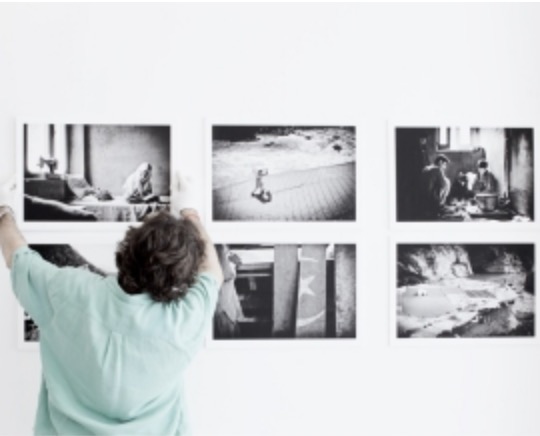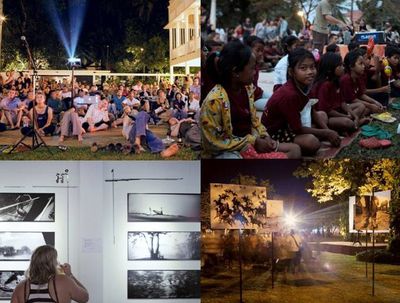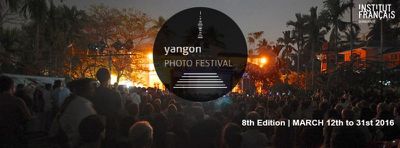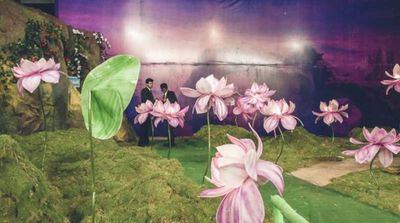By Angkor Photo Festival & Workshops
Visual Perspective Series 2 | Traditional sports

http://vimeo.com/31413076
culture360.org and Angkor Photo Festival present the second of a series of bi-monthly photo stories by one Asian and one European photographer who are exploring similar themes or issues in their work.
In this second series, we present Sumo by Jill Coulon and Wrestling by Palani Mohan for Reportage by Getty Images. Through their images, we enter two very different worlds of ancient sports that originated from very different cultures, but both of which have endured through centuries till the present day.
Sumo was shown at the 2008 Angkor Photo Festival, and Wrestling was shown in 2010.
A sport with a 3,000-year-old history, kushti is still practiced in small pockets of India, Pakistan and Iran. Travelling to the small city of Kolhapur in Maharashtra, regarded to be the main center of the sport, Palani Mohan shares with us an inside view of an amazing tradition steeped with rich moral, ethical, philosophical and mystical heritage.
Through wonderfully evocative images, Palani takes into the world of an ancient sport that is now under threat. As he explains in his statement, India’s sporting authorities are now seeking to force its best practitioners to turn to more recognised wrestling styles after the success received by Indian wrestlers at the 2008 Olympic Games. The number of wrestlers has also declined along with the number of schools, and “old-timers complain that the younger wrestlers lack the commitment to keep the sport alive.”
As in some of Palani’s other work, colour and atmosphere takes a forefront in the visual makeup of the images - the warm tones of the wrestlers’ skin and cloths, mixed with the red, earthy soil of the circular pit in which they wrestle, transplants us into another time and era when there were still hundreds of Akhadas (wrestling schools) all over the city.
The sport’s ancestry is that of the warrior, and it is indeed the faces and bodies of warriors - both young and old - that Palani reveals to us in his images, which capture the essence of a kushti wrestler’s masculine athleticism. In both his startlingly clear portraits and photos of duos wrestling - frozen, as if posing for an artist’s brush - the figures bring to mind the classical Greek and Roman sculptures in which the male figure is highly idealised.
Palani also brings us into the lives of these wrestlers, showing us as they rest, take their baths, and even a glimpse into their sleeping quarters.
For Jill Coulon, this “inside” look into the lives of the wrestlers forms a large part of her story’s narrative. Both sumo and kushti demand a lot from their practitioners, who have to completely commit their time, bodies and lifestyles to the sport. For both, the wrestlers form communities who live together, following strict diet and exercise routines.
For Jill, who came from France knowing very little about Japan’s most beloved national sport, she was amazed to realise how these wrestlers, some of whom are as young as 14 years old, had to follow a highly regimented life when they joined a sumo stable. As she became better acquainted with the wrestlers, she became intrigued by how they were “just like any teenager”, in spite of their deep commitment to the sport.
And so, we see Jill’s interest with the daily and personal lives of these wrestlers in her images. From playing arcade games, taking the subway, resting in their rooms etc., the protagonists of Jill’s story may sometimes look a little ‘out of place’ as they are juxtaposed in modern Japanese society. This portrayal deviates from Palani’s work, which consistently maintains the aura of a period from long ago.
For Jill, who was a foreigner who did not speak the language, access into the world of sumo was not something easy to come by. Women are considered ‘impure’ by the Shinto religion, and as Jill explains, “It is a very closed world, even for Japanese people.” It was an introduction by a senior sumo wrestler that led her to spend six months living in Oshima Beya, a sumo stable in Tokyo.
“At the beginning it was really hard, but after a while, I could go there on my own and make myself understood and above all, I could be there without talking to them as they had forgotten about me, I was part of their life and that was it.”
A sport that dates back more than 1,000 years, sumo originated as a rite of the Shinto religion, and remains highly ritualised even today. As we see in Jill’s images, many wrestlers begin their professional careers at very young ages.
Jill writes about her experience, ”After six months living with them and learning about the tradition and the rules, I am now not only a big fan of the sport, but I do understand why some young people would want to change their bodies and lives to become a sumo wrestler. I also do have a lot of tenderness for these young ‘big’ guys.”
Jill’s immersion into their lives and her affection for the wrestlers clearly influences her work and its focus. In a slightly raw, documentative style, she portrays them in a gentle and almost delicate light, showing us the men behind the sport and their lives outside the dhoyo (the ring in which sumo matches take place). While we also see them during their practice sessions, it is the candid, personal moments recorded by Jill that brings us deeper into the lives of these men.
While the sumo and kushti wrestlers bear little physical similarity with each other, through the lens of Jill and Palani, their formidable power and Herculean strength, along with their commitment to the tradition they have embraced, remains indubitable.
The Photographers
Palani Mohan was born in Madras, India in 1967 and migrated to Australia with his family in 1979. His photographic career began at the Sydney Morning Herald newspaper in 1985, and he moved to Asia in 1999. His works have been published by many of the world's leading magazines and newspapers including National Geographic, Stern, Time, Newsweek, The New York Times and has also published three photographic books. Palani's work has been recognized with awards from World Press Photo, Picture of the Year, National Press Photographers Association, American Photo and Communication Arts. He is represented by Getty Images' Reportage Group in New York and is currently based in the Malaysian capital Kuala Lumpur.
(Website: http://www.palanimohan.com)
Jill Coulon has been passionate about photography for more than 15 years, and has been working on documentary films for more than nine years. She first worked with international documentary producer Christine Le Goff (The Origins of Aids, Wild Blue Yonder). Then she assisted Thomas Balmès on his feature Babies and worked with him for four years. In 2008 she left for Tokyo for six full months alone with her camera in a sumo stable for her first documentary film for NHK (Japan) and Planète (France), titled A Normal Life, chronicle of a sumo wrestler. Her film was selected for many international festivals and received several awards such as Best First Film at MiradasDoc, Special Jury Mention at Flahertiana, Etoile de la SCAM 2010 and Special Jury Mention at Festival du film d'éducation. In 2010, she assisted Frédéric Laffont on Les mains d'Hermès, a film about the French craftsmen working at Hermès. She is currently developing her new projects.
(Website: www.jillcoulon.com)
Jessica Lim is the Asia Coordinator of the Angkor Photo Festival.
Created in 2005, the annual Angkor Photo Festival is the first such event to be held in Southeast Asia. A member of the Asia Pacific PhotoForum, the weeklong festival showcases work by photographers all over the world, and acts as a platform for discovering new talent and encourages the exchange of ideas across continents.
Similar content
posted on
posted on
posted on
posted on
posted on
posted on





